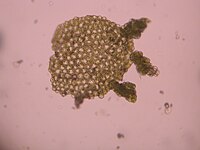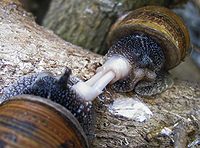
Folivory has long‐term effects on sexual but not on asexual reproduction in woodland strawberry
Sign Up to like & getrecommendations! Published in 2018 at "Ecology and Evolution"
DOI: 10.1002/ece3.4687
Abstract: Abstract Plant fitness is often a result of both sexual and asexual reproductive success and, in perennial plants, over several years. Folivory can affect both modes of reproduction. However, little is known about the effects… read more here.
Keywords: folivory; year; woodland strawberry; sexual asexual ... See more keywords

Sexual and asexual development: two distinct programs producing the same tunicate
Sign Up to like & getrecommendations! Published in 2021 at "Cell reports"
DOI: 10.1016/j.celrep.2020.108681
Abstract: SUMMARY Colonial tunicates are the only chordate that possess two distinct developmental pathways to produce an adult body: either sexually through embryogenesis or asexually through a stem cell-mediated renewal termed blastogenesis. Using the colonial tunicate… read more here.
Keywords: asexual development; programs producing; sexual asexual; development two ... See more keywords

Reproductive polyphenism and its advantages in aphids: Switching between sexual and asexual reproduction
Sign Up to like & getrecommendations! Published in 2020 at "Journal of Integrative Agriculture"
DOI: 10.1016/s2095-3119(19)62767-x
Abstract: Abstract Reproductive polyphenism, which allows one genotype to produce sexual and asexual morphs, is an extreme case of phenotypic plasticity and is commonly observed in aphids. Aphids are typical species that switch these reproductive modes,… read more here.
Keywords: polyphenism advantages; reproductive polyphenism; asexual reproduction; sexual asexual ... See more keywords

Fundamental and realized feeding niche breadths of sexual and asexual stick insects
Sign Up to like & getrecommendations! Published in 2018 at "Proceedings of the Royal Society B: Biological Sciences"
DOI: 10.1098/rspb.2018.1805
Abstract: The factors contributing to the maintenance of sex over asexuality in natural populations remain unclear. Ecological divergences between sexual and asexual lineages could help to maintain reproductive polymorphisms, at least transiently, but the consequences of… read more here.
Keywords: insects; feeding niche; realized feeding; sexual asexual ... See more keywords

Asymmetric density‐dependent competition does not contribute to the maintenance of sex in a mixed population of sexual and asexual Potamopyrgus antipodarum
Sign Up to like & getrecommendations! Published in 2022 at "Journal of Evolutionary Biology"
DOI: 10.1111/jeb.14030
Abstract: Asexual reproduction is expected to have a twofold reproductive advantage over sexual reproduction, owing to the cost of producing males in sexual subpopulations. The persistence of sexual females, thus, requires an advantage to sexual reproduction,… read more here.
Keywords: density; competition; potamopyrgus antipodarum; sexual asexual ... See more keywords

The for gene as one of the drivers of foraging variations in a parasitic wasp
Sign Up to like & getrecommendations! Published in 2022 at "Molecular Ecology"
DOI: 10.1111/mec.16834
Abstract: Foraging behaviours encompass strategies to locate resources and to exploit them. In many taxa, these behaviours are driven by a major gene called for, but the mechanisms of gene regulation vary between species. In the… read more here.
Keywords: drivers foraging; sexual asexual; gene one; foraging behaviours ... See more keywords

Molecular phylogeny of Aplosporella abexaminans: a novel species revealing the second report of sexual-asexual connection in Aplosporellaceae (Botryosphaeriales) from India
Sign Up to like & getrecommendations! Published in 2021 at "Phytotaxa"
DOI: 10.11646/phytotaxa.525.3.3
Abstract: Aplosporella abexaminans, a new sexual morph fungus belongs to family Aplosporellaceae, was discovered on the bark of stem of Murraya koenigii (Rutaceae) and identified by morphological characteristics and analysis of combined ITS and LSU sequence… read more here.
Keywords: report sexual; asexual connection; second report; sexual asexual ... See more keywords

Karyotype Variability and Inter-Population Genomic Differences in Freshwater Ostracods (Crustacea) Showing Geographical Parthenogenesis
Sign Up to like & getrecommendations! Published in 2018 at "Genes"
DOI: 10.3390/genes9030150
Abstract: Transitions from sexual to asexual reproduction are often associated with polyploidy and increased chromosomal plasticity in asexuals. We investigated chromosomes in the freshwater ostracod species Eucypris virens (Jurine, 1820), where sexual, asexual and mixed populations… read more here.
Keywords: variability inter; variability; sexual asexual; inter population ... See more keywords

Evidence for stronger discrimination between conspecific and heterospecific mating partners in sexual vs. asexual female freshwater snails
Sign Up to like & getrecommendations! Published in 2022 at "PeerJ"
DOI: 10.7717/peerj.14470
Abstract: Once-useful traits that no longer contribute to fitness tend to decay over time. Here, we address whether the expression of mating-related traits that increase the fitness of sexually reproducing individuals but are likely less useful… read more here.
Keywords: freshwater; mating partners; sexual asexual; heterospecific mating ... See more keywords